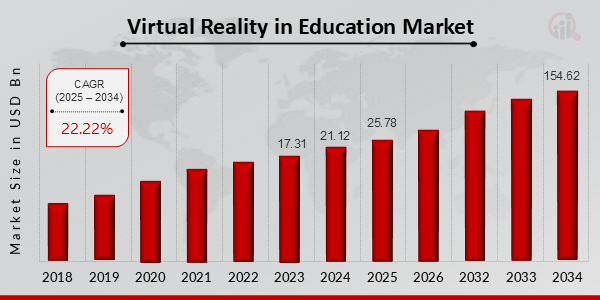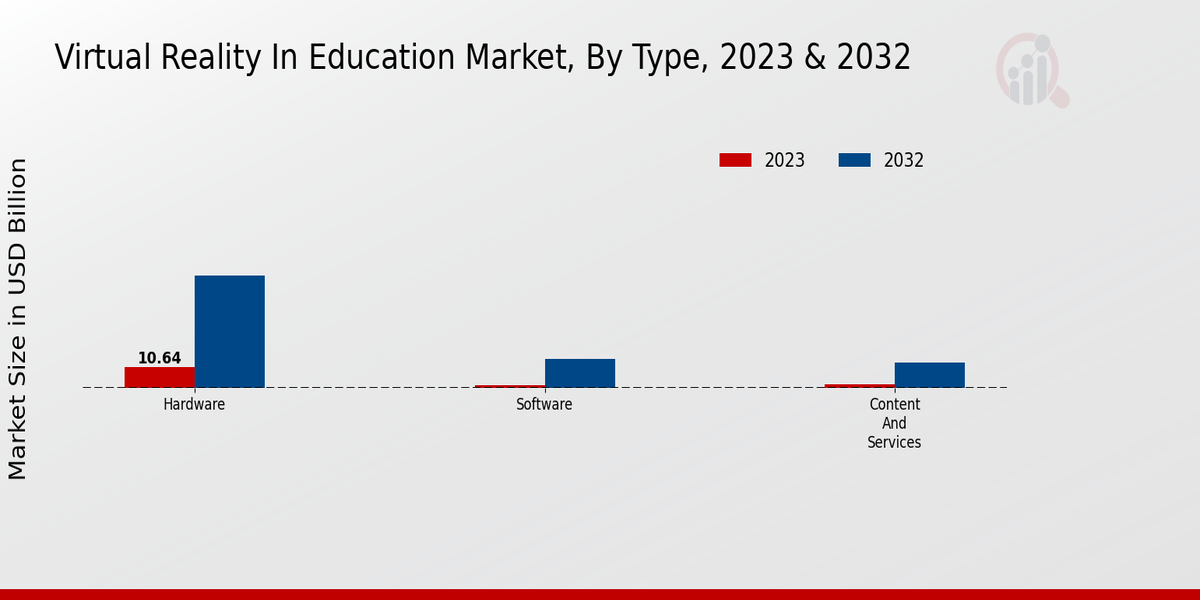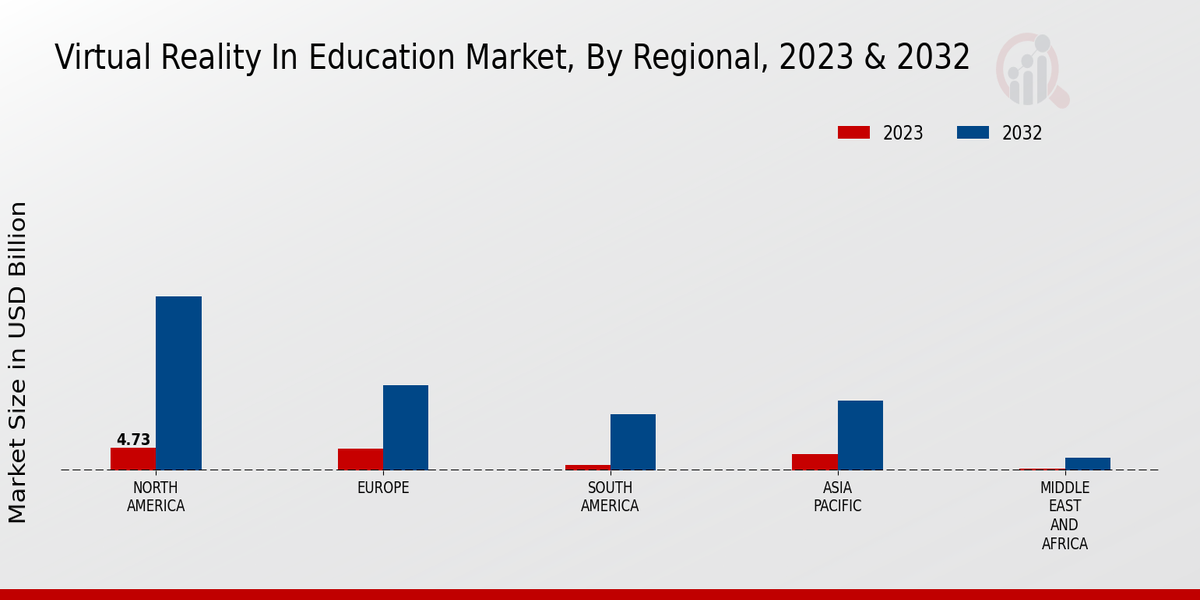Virtual Reality in Education Market Overview
Virtual Reality in Education Market is projected to grow from USD 25.78 billion in 2025 to USD 154.62 billion by 2034, exhibiting a compound annual growth rate (CAGR) of 22.22% during the forecast period (2025 - 2034). Additionally, the market size for Virtual Reality in Education Market was valued at USD 21.12 billion in 2024.
Key Virtual Reality in Education Market Trends Highlighted
Growing demand for immersive and engaging educational experiences Integration of VR technology into curricula to enhance student learning outcomes Government initiatives and funding to support the adoption of VR in education Technological advancements, such as improved VR headsets and reduced hardware costs Development of specialized VR content and educational software tailored to specific subjects and skill sets. Partnerships with educational institutions and EdTech companies to create and distribute VR-based learning materials.
Expansion into emerging markets with growing demand for innovative educational solutionsIncreasing focus on using VR for STEM (science, technology, engineering, and mathematics) education, providing immersive simulations and hands-on experiences Integration of VR with augmented reality (AR) and virtual environments to create blended learning experiences The emergence of cloud-based VR platforms, enabling wider access to VR content and reducing hardware dependencies Rapid adoption of VR headsets in higher education, enhancing student engagement and fostering collaboration. Growing interest in using VR for special education needs and individualized learning experiences
Figure 1: Virtual Reality in Education Market, 2025 - 2034

Source: Primary Research, Secondary Research, MRFR Database and Analyst Review
Virtual Reality in Education Market Drivers
Rising Demand for Immersive Learning Experiences
Virtual reality is being integrated into the learning process due to increased interest in immersive education. Through VR technology, students can explore different concepts in a way that is unique and interactive for both formal and informal educational settings. By so doing, they learn with meaning and better remember ideas. As we live in the age of digital technologies, education is becoming more experiential than ever before, with virtual realities being incorporated into many school and university curricula. Additionally, it fits with Gen Z and younger people who have experienced the world virtually and expect interactive, stimulus-packed platforms for their learning to take place.
Advancements in VR Technology and Content Development
The Virtual Reality in Education Market Industry is driven by the rapid advancements in VR technology and the increasing availability of high-quality educational VR content. Technological innovations such as the improvement of headset designs, better resolution displays, and better tracking systems enhance the more immersive and realistic experience of VR. Content developers are also creating a wide range of educational VR applications, simulations, and games for different subjects/ fields of study. These developments increase the attractiveness, ease of use, and efficacy of virtual reality in education.
Government Initiatives and Funding for VR in Education
Government initiatives and funding opportunities are central to promoting the ever-wider adoption of VR. As the technology is recognized by various governments across the globe as groundbreaking, opportunities for research, development, and even implementation of VR programs in schools and universities have been funded. Moreover, support through grants, subsidies, and even tax breaks enables educational institutions to establish VR infrastructure and develop VR-based learning solutions. In conclusion, government initiatives and funding create a favorable environment promoting the expansion of the Global Virtual Reality in the Education Market Industry.
Virtual Reality in Education Market Segment Insights
Virtual Reality in Education Market Type Insights
The Virtual Reality in Education Market is segmented by type into hardware, software, and content and services. As hardware has the highest cost, it is expected to be the largest market segment; however, software is expected to be the fastest-growing segment as more VR-based educational software is being developed. The content and services segment is also expected to grow at a rapid pace, with more VR-based educational content being created and more services being developed to support VR-based education. In 2023, the Virtual Reality in Education Market was valued at 14.19 USD Billion. The growth is attributed to the increase in the adoption of VR technology in education and the growth in the availability of VR-based educational content and services.
A few large players dominate the hardware segment in the Virtual Reality in Education Market, such as HTC, Oculus, and Sony. These companies offer VR headsets and other components that are used in VR-based educational applications. The software segment in the market is more fragmented, with small and medium-sized companies providing VR-based educational software. The content and services segment is also fragmented, with a number of companies providing VR-based educational content and services. The Virtual Reality in Education Market is expected to grow as the cost of VR hardware decreases, and more educational institutions begin to offer VR-based education. The Global Virtual Education Reality Market is a rapidly growing market.
Figure 2: Virtual Reality in Education Market, By Platform, 2025 & 2034

Source: Primary Research, Secondary Research, MRFR Database and Analyst Review
Virtual Reality in Education Market Application Insights
The Virtual Reality in Education Market segmentation by Application is broadly classified into Classroom Training, Simulation and Training, Lab Experiments, Immersive Field Trips, and Educational Games. Among these segments, Classroom Training captured a significant market share in 2023 and is anticipated to maintain its dominance throughout the forecast period, owing to the growing adoption of VR technology in educational institutions to enhance student engagement and improve learning outcomes. The simulation and Training segment is expected to witness substantial growth in the coming years, driven by the increasing use of VR for training simulations in various fields, such as medical, military, and engineering.
The lab Experiments segment is also projected to grow steadily, as VR provides a safe and immersive environment for students to conduct experiments and explore complex scientific concepts. Immersive Field Trips and Educational Games segments are anticipated to gain traction as VR technology becomes more accessible and affordable for schools and educational institutions.
Virtual Reality in Education Market End-User Insights
The Virtual Reality in Education Market is segmented by End-User into K-12 Education, Higher Education, Corporate Training, and Government and Military. Among these segments, K-12 Education is expected to hold the largest market share in 2023, owing to the increasing adoption of VR technology in classrooms to enhance student engagement and improve learning outcomes. Higher Education is expected to be the fastest-growing segment over the forecast period due to the rising demand for immersive and interactive learning experiences in universities and colleges. Corporate Training is also expected to witness significant growth as companies increasingly use VR for employee training and development. Government and Military is another important segment, with VR being used for simulation and training purposes in various government agencies and military organizations.
Virtual Reality in Education Market Device Type Insights
The Virtual Reality in Education Market is segmented by Device Type into Head-mounted Displays (HMDs), Mobile Virtual Reality (VR) Headsets, and Desktop Virtual Reality Systems. Head-mounted Displays (HMDs) held the largest market share, accounting for over 60% of the Virtual Reality in Education Market revenue in 2023. They offer an immersive experience and are becoming increasingly popular in education as they allow students to interact with virtual environments and simulations. Mobile Virtual Reality (VR) Headsets are expected to witness the fastest growth over the forecast period, owing to their affordability and accessibility. Desktop Virtual Reality Systems provide a high-quality VR experience but are more expensive and less portable than other device types. The Virtual Reality in Education Market is expected to reach a market valuation of USD 16.19 Billion by 2024, exhibiting a Compound Annual Growth Rate (CAGR) of 22.02% during the forecast period.
Virtual Reality in Education Market Regional Insights
Regional Segment Insights and Overview The Virtual Reality in Education Market is segmented into North America, Europe, APAC, South America, and MEA. Among these regions, North America held the largest market share in 2023 and is projected to continue its dominance throughout the forecast period. The region's strong economic growth, high adoption of advanced technologies, and presence of major industry players contribute to its leading position. Europe is another significant region, driven by factors such as government initiatives supporting VR in education and a growing demand for immersive learning experiences.APAC is expected to emerge as a high-growth market, fueled by increasing investments in education infrastructure and rising disposable income levels. South America and MEA are also witnessing growing demand for VR in education, but their market share is relatively smaller compared to other regions.
Figure 3: Virtual Reality in Education Market, By Regional, 2025 & 2034

Source: Primary Research, Secondary Research, MRFR Database and Analyst Review
Virtual Reality in Education Market Key Players And Competitive Insights
The main players in the VR in education market are innovating and developing new products in this timeless industry. Leading market players concentrate on developing modern VR headsets and software that pave the way for immersive, exciting learning experiences. Over the years, Virtual Reality in Education Market has witnessed substantial growth and is likely to register significant demand throughout the forecast period due to the increasing implementation of VR technology in educational facilities. Both well-established and emerging players form the competitive market of the subsegment. Consequently, the key players in the virtual reality education market include Google, Samsung, Sony, HTC, and Oculus. They undoubtedly take steps to guarantee that their firms are industry leaders and are involved in considerable research and development in order to realize that ambition.
One of the leading companies in this market is Meta Platforms, Inc. This company offers a wide range of products, such as virtual reality glasses and specialized software for educational institutions. The organization’s general goal is to ensure that such technology is accessible to all students and teachers. Consequently, their production is relatively low-cost, and the software accompanying it is quite stimulating and educational. Meta Platforms, Inc. is currently working with many educational institutions to develop a suitable program. Yet another prominent player in the Virtual Reality in Education Market is HTC Vive, offering a variety of virtual reality accessories and software. At the same time, some tools can be designed for the average consumer, while others are for corporate clients. Their virtual reality glasses are among the best in terms of quality and performance. Objectively, the user-friendly software provides an exciting user experience. The company also collaborates with educational institutions and has the primary goal of ensuring the affordability of these accessories for students and teachers.
Key Companies in the Virtual Reality in Education Market Include
- Pimax
- Meta Platforms, Inc.
- ClassVR
- Microsoft Corporation
- Pico Interactive
- HTC Corporation
- Skyworth
- Samsung Electronics Co., Ltd.
- DPVR
- Unisteer
- Google LLC
- Talespin
- VictoryXR
- Varjo Technologies Oy
- Sony Interactive Entertainment LLC
Virtual Reality in Education Market Industry Developments
The global virtual reality (VR) in education market is projected to grow significantly in the coming years. In 2023, the market was valued at approximately USD 14.19 billion, and it is expected to reach USD 85.1 billion by 2032, exhibiting a CAGR of 22.02% during the forecast period. The increasing adoption of VR technology in educational institutions is attributed to its ability to provide immersive and interactive learning experiences. VR allows students to engage with educational content in a virtual environment, enhancing their understanding and retention of concepts.
The growing demand for personalized and engaging learning solutions, along with the integration of VR with other emerging technologies such as artificial intelligence (AI) and augmented reality (AR), is further fueling the market growth. Strategic partnerships between educational institutions and VR solution providers are also contributing to the market expansion.
Virtual Reality in Education Market Segmentation Insights
Virtual Reality in Education Market Type Outlook
- Hardware
- Software
- Content and Services
Virtual Reality in Education Market Application Outlook
- Classroom Training
- Simulation and Training
- Lab Experiments
- Immersive Field Trips
- Educational Games
Virtual Reality in Education Market End-User Outlook
- K-12 Education
- Higher Education
- Corporate Training
- Government and Military
Virtual Reality in Education Market Device Type Outlook
- Head-mounted Displays (HMDs)
- Mobile Virtual Reality (VR) Headsets
- Desktop Virtual Reality Systems
Virtual Reality in Education Market Regional Outlook
- North America
- Europe
- South America
- Asia Pacific
- Middle East and Africa
|
Report Attribute/Metric
|
Details
|
|
Market Size 2024
|
21.12 (USD Billion)
|
|
Market Size 2025
|
25.7821.12 (USD Billion)
|
|
Market Size 2034
|
154.62 (USD Billion)
|
|
Compound Annual Growth Rate (CAGR)
|
22.22% (2025 - 2034)
|
|
Report Coverage
|
Revenue Forecast, Competitive Landscape, Growth Factors, and Trends
|
|
Base Year
|
2024
|
|
Market Forecast Period
|
2025 - 2034
|
|
Historical Data
|
2019 - 2023
|
|
Market Forecast Units
|
USD Billion
|
| Key Companies Profiled |
Pimax, Meta Platforms, Inc., ClassVR, Microsoft Corporation, Pico Interactive, HTC Corporation, Skyworth, Samsung Electronics Co., Ltd., DPVR, Unisteer, Google LLC, Talespin, VictoryXR, Varjo Technologies Oy, Sony Interactive Entertainment LLC |
| Segments Covered |
Type, Application, End-User, Device Type, Regional |
| Key Market Opportunities |
Immersive Learning Experiences Personalized Education Gamification of Learning Skill Development and Training Remote and Accessible Education |
| Key Market Dynamics |
1 Increasing adoption of VR technology in education2 Growing demand for immersive and engaging learning experiences3 Government initiatives to promote VR Education4 Strategic partnerships between VR companies and educational institutions5 Advancement in VR hardware and software capabilities |
| Countries Covered |
North America, Europe, APAC, South America, MEA |
Frequently Asked Questions (FAQ) :
The Virtual Reality in Education Market size was valued at USD 147.31 billion in 2023 and is projected to reach USD 154.62 billion by 2034, growing at a CAGR of 22.22% from 2025 to 2034.
The key regions in the global Virtual Reality Education Market are North America, Europe, Asia Pacific, Latin America, and the Middle East and Africa. North America is the largest market, followed by Europe and Asia Pacific.
The key applications of Virtual Reality in Education include teacher training, student assessment, immersive learning experiences, and remote learning.
The key growth drivers of global virtual reality in education include the increasing demand for immersive learning experiences, government initiatives to promote the use of technology in education, and the rising popularity of online learning.
The key challenges facing the Virtual Reality in Education Market include the high cost of VR headsets, the lack of VR-compatible content, and the need for teacher training.
The key competitors in the Virtual Reality in Education Market include Google, Meta Platforms, Microsoft, HTC Vive, and Sony Interactive Entertainment.
The latest trends in the global virtual reality education market include the development of standalone VR headsets, the increasing availability of VR-compatible content, and the growing use of VR for remote learning.
The key opportunities for growth in the Virtual Reality in Education Market include the increasing adoption of VR in schools and universities, the development of new VR-based learning applications, and the growing demand for VR-based teacher training.
The key challenges facing the Virtual Reality in Education Market include the high cost of VR headsets, the lack of VR-compatible content, and the need for teacher training.
The Virtual Reality in Education Market is expected to grow at a CAGR of 22.22% from 2025 to 2034.

















